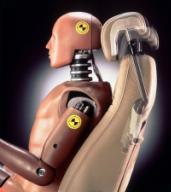IIHS Study Touts Saab's Active Head Restraint
 |
NORCROSS, Ga., Oct. 24 -- New research from the Insurance Institute for Highway Safety (IIHS) has determined that Saab's Active Head Restraint (SAHR) system reduces neck injuries among car occupants by 43 percent. The study measures the effectiveness of the SAHR system by comparing the rates of insurance claims for driver neck injuries in rear-end crashes before and after the SAHR system was introduced. Nationwide, Progressive and State Farm insurance companies supplied claims data for the study and participated in the research. The SAHR system was introduced in 1997 as the world's first active, anti-whiplash head restraint and is standard equipment in all Saab models.
"The IIHS study reaffirms our own research that the SAHR system is effective in reducing whiplash in rear-end collisions," said Stefan Olsen, development engineer in Saab's Collision and Safety Department. "It's more evidence that our real-life safety philosophy is sound. Good laboratory tests are helpful, but what is most important is that our safety systems perform well in real-life crashes."
The 43 percent reduction in claim rates is significant because the SAHR system is compared to Saab's previous head restraints which were, at the time, considered 'best in class' by the Swedish insurance company, Folksam.
In the IIHS study, the reduction in neck injuries were greater for women than men. The SAHR system produced a 55 percent reduction in claim rates for women, compared with a 31 percent reduction for men. The SAHR system provides multiple adjustment points to allow the head restraint to be ideally positioned for most front-seat occupants.
In a study released last year by the Journal of Trauma, Saab's Active Head Restraint system was determined to reduce the risk of neck injuries relating to whiplash in rear-end collisions by as much as 75 percent.
Real-life crash statistics show that neck injuries are one of the most common results of rear-end collisions, even at relatively low speeds. The triggering factor in these whiplash injuries is the violent movement of the head in relation to the body during an impact from behind, often leaving victims with long-term pain. In the event of a rear-end collision, the SAHR system is designed to limit the head movement of the occupant during the impact, helping to reduce the risk of whiplash injuries.
The system is entirely mechanical and is based on the lever principle. An upper padded support is connected to a pressure plate in the backrest of the seat. In some rear collisions, the occupant's body will be forced by the crash pulse into the backrest, which moves the pressure plate towards the rear. Subsequently, the head restraint is moved up and forward to "catch" the occupant's head before the whiplash movement can start. The precise activation of the system is determined by the force with which the occupant's back is forced against the backrest, the magnitude of the collision forces and by the occupant's weight.
A benefit of the mechanical SAHR system is that in most crashes it needs no repairs to restore it to operational condition after it has been activated. After the head restraint has constrained the movement of the head, it reverts to its initial position and is immediately ready to operate again. As whiplash injuries usually occur in low-speed collisions in which the vehicle may sustain only limited damage, the active head restraint does not increase the cost of the repairs needed after the crash.
Saab's new 2003 9-3 Sport Sedan features a "second generation" SAHR for even faster activation in rear impacts at lower speeds. The head restraint is activated as soon as the lower back is pressed into the seatback by the occupant's inertia during a rear impact.
For more information on the IIHS study, see www.highwaysafety.org . For more information about the SAHR, see www.saabusa.com .


